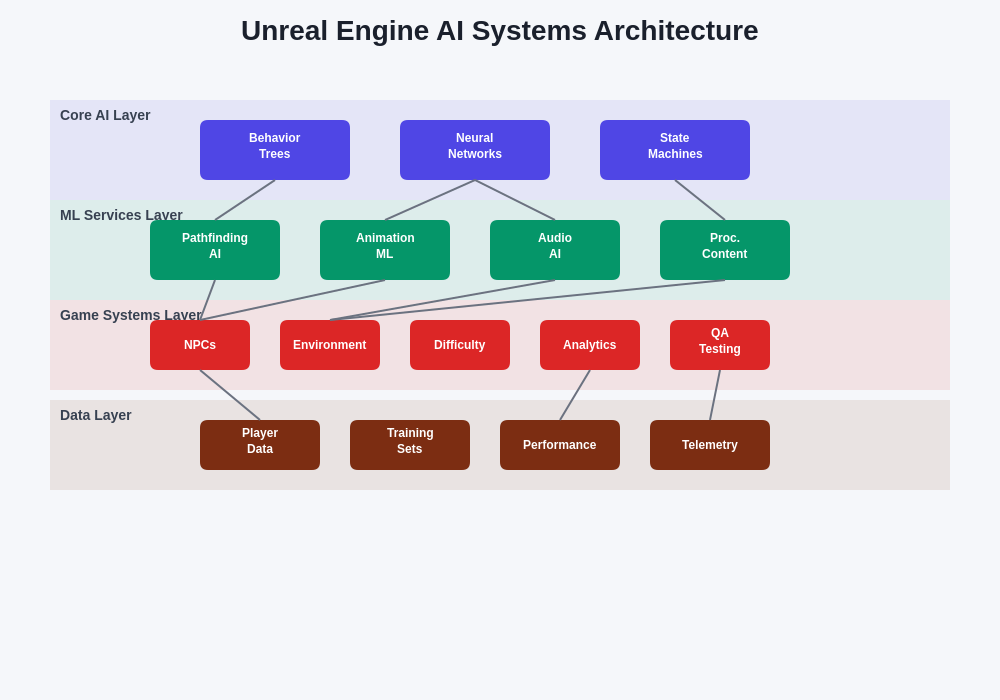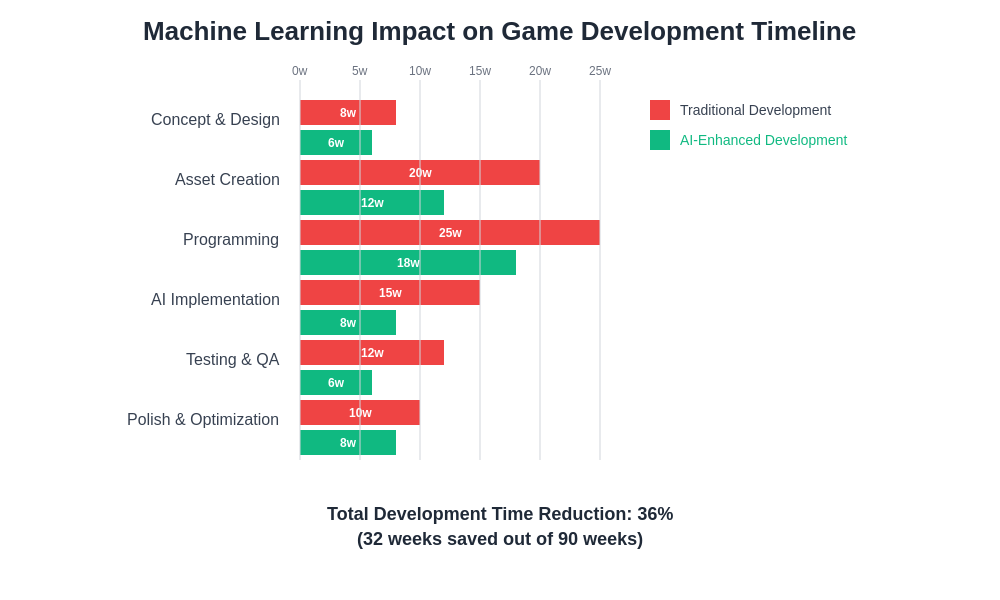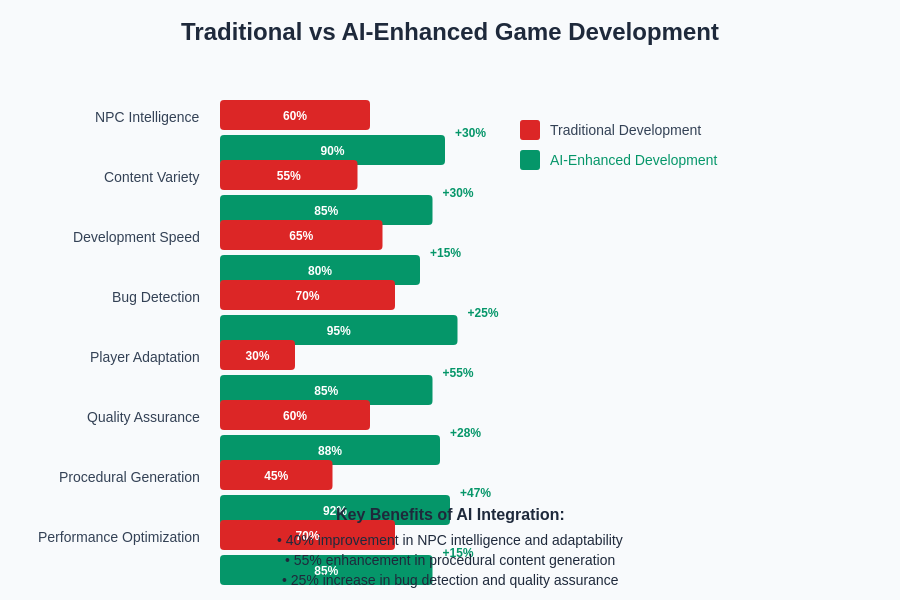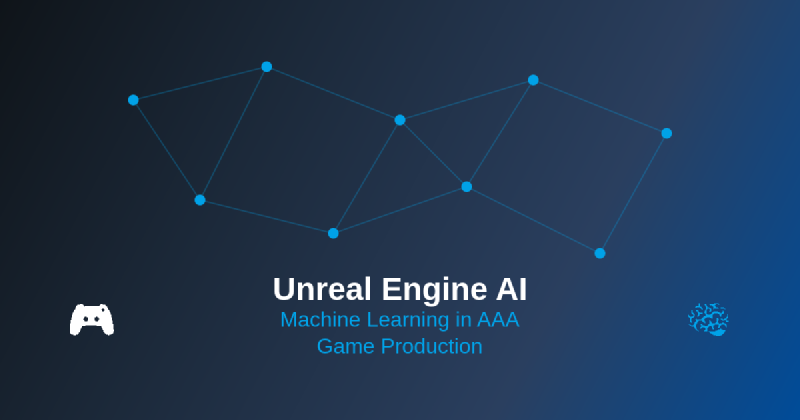The convergence of artificial intelligence and game development has reached a revolutionary crescendo with Unreal Engine’s comprehensive machine learning integration, fundamentally transforming how AAA studios conceptualize, develop, and deliver immersive gaming experiences. This technological evolution represents far more than incremental improvements to existing systems; it embodies a paradigmatic shift that is redefining the boundaries between human creativity and machine intelligence in the pursuit of creating unprecedented interactive entertainment experiences.
Explore the latest AI developments in gaming to witness firsthand how cutting-edge artificial intelligence technologies are continuously reshaping the landscape of interactive entertainment and pushing the boundaries of what’s possible in digital worlds. The integration of machine learning within Unreal Engine has unlocked creative possibilities that were previously confined to the realm of science fiction, enabling developers to craft experiences that adapt, learn, and evolve in response to player behavior and preferences.
The Evolution of AI in Game Development
The journey from scripted behaviors to intelligent, learning systems represents one of the most significant technological leaps in the history of game development. Traditional game AI relied heavily on finite state machines and predetermined decision trees that, while functional, created predictable and often repetitive gameplay experiences that failed to capture the dynamic complexity of real-world interactions. Unreal Engine’s machine learning capabilities have transcended these limitations by introducing systems that can analyze player behavior patterns, adapt to changing circumstances, and generate responses that feel genuinely intelligent and contextually appropriate.
This evolution has been particularly transformative in the realm of non-player character development, where machine learning algorithms enable NPCs to exhibit sophisticated behavioral patterns that respond dynamically to environmental changes, player actions, and contextual variables. The result is a new generation of virtual characters that feel authentically alive, capable of learning from interactions and developing unique personality traits that emerge organically through gameplay rather than being hardcoded by developers.
Intelligent NPC Behavior Systems
The implementation of machine learning in NPC behavior represents perhaps the most visible and impactful application of AI in modern game development. Unreal Engine’s neural network integration allows NPCs to process vast amounts of environmental data, player interaction history, and contextual information to make decisions that feel natural and appropriate to the specific situation at hand. These systems go beyond simple reactive programming to incorporate predictive modeling that enables NPCs to anticipate player actions and respond proactively rather than merely reacting to events as they occur.
Advanced behavior trees powered by machine learning algorithms enable NPCs to exhibit complex emotional responses, form relationships with players and other characters, and develop preferences and aversions based on accumulated experiences. This creates gameplay scenarios where every interaction contributes to the evolving personality and behavioral patterns of virtual characters, resulting in emergent storytelling opportunities that arise naturally from the interplay between player choices and AI responses.
Experience next-generation AI capabilities with Claude to understand how sophisticated reasoning and natural language processing can enhance character development and narrative generation in interactive entertainment. The integration of advanced language models with game AI systems opens new possibilities for dynamic dialogue generation, contextual storytelling, and personalized narrative experiences that adapt to individual player preferences and play styles.
Procedural Content Generation Revolution
Machine learning has revolutionized procedural content generation in Unreal Engine by replacing rule-based algorithms with intelligent systems that can understand artistic intent, aesthetic preferences, and gameplay balance requirements. These AI-driven generation systems can create vast, diverse game worlds that maintain artistic coherence while offering virtually unlimited exploration opportunities for players. The technology extends beyond simple terrain generation to encompass complex architectural structures, intricate dungeon layouts, and even complete ecosystems that evolve dynamically based on player interactions and environmental factors.
The sophistication of these systems enables developers to create games with unprecedented scope and variety while maintaining the high production values expected in AAA titles. Machine learning algorithms can generate textures, models, and animations that seamlessly integrate with hand-crafted assets, ensuring that procedurally generated content maintains the same level of polish and artistic vision as traditionally created elements. This hybrid approach allows development teams to achieve massive scale without compromising on quality or artistic integrity.
Real-Time Animation and Motion Synthesis
The integration of machine learning into Unreal Engine’s animation systems has enabled breakthrough capabilities in real-time motion synthesis and character animation. Neural networks trained on vast datasets of human and animal movement can generate fluid, contextually appropriate animations that respond dynamically to environmental conditions, character states, and gameplay situations. This technology eliminates the need for extensive motion capture sessions for every possible movement combination while ensuring that character animations maintain naturalistic quality and emotional authenticity.
Advanced inverse kinematics systems powered by machine learning can adapt character movements to irregular terrain, dynamic obstacles, and changing environmental conditions in real-time, creating seamless animation transitions that enhance immersion and believability. These systems can also generate facial animations, lip-syncing, and emotional expressions that correspond accurately to dialogue content and contextual situations, significantly reducing the time and resources required for traditional animation workflows.

The architectural foundation of Unreal Engine’s AI systems demonstrates the sophisticated integration of multiple machine learning components working in harmony to create intelligent, responsive, and adaptive game experiences. This comprehensive approach ensures that AI functionality permeates every aspect of game development from character behavior to environmental systems.
Advanced Pathfinding and Navigation
Traditional pathfinding algorithms, while effective for basic navigation, often produced mechanical and predictable movement patterns that broke immersion and limited the complexity of possible gameplay scenarios. Unreal Engine’s machine learning-enhanced navigation systems utilize reinforcement learning algorithms that enable characters to develop sophisticated understanding of spatial relationships, environmental hazards, and strategic positioning considerations. These AI agents can learn optimal routes through complex environments, adapt to dynamic obstacles, and even develop preferences for certain paths based on accumulated experience and contextual factors.
The implementation of neural pathfinding extends beyond simple point-to-point navigation to incorporate tactical considerations, group coordination, and strategic positioning that reflects genuine intelligence rather than algorithmic optimization. Characters powered by these systems can exhibit flanking behaviors, coordinate team movements, and adapt their navigation strategies based on player behavior patterns and environmental changes, creating combat and interaction scenarios that feel genuinely challenging and unpredictable.
Dynamic Difficulty Adjustment Systems
One of the most sophisticated applications of machine learning in Unreal Engine involves dynamic difficulty adjustment systems that monitor player performance, engagement levels, and frustration indicators to optimize the gameplay experience in real-time. These systems utilize complex algorithms that analyze multiple data streams including player success rates, time spent on challenges, input patterns, and even biometric data when available to create personalized difficulty curves that maintain optimal engagement without causing excessive frustration or boredom.
The sophistication of these systems extends beyond simple parameter adjustments to encompass comprehensive gameplay modifications including enemy AI intelligence levels, resource availability, environmental hazards, and even narrative pacing adjustments. Machine learning algorithms can identify when players are becoming disengaged or overwhelmed and make subtle modifications to the game experience that restore optimal challenge levels while maintaining the integrity of the intended gameplay experience.
Discover comprehensive AI research capabilities with Perplexity to explore the latest developments in machine learning applications for interactive entertainment and understand how cutting-edge research translates into practical game development solutions. The continuous advancement of AI research directly impacts the capabilities available to game developers and opens new possibilities for creating engaging interactive experiences.
Automated Quality Assurance and Testing
The application of machine learning to quality assurance represents a transformative advancement that addresses one of the most resource-intensive aspects of AAA game development. AI-powered testing systems can simulate thousands of hours of gameplay across multiple difficulty levels, play styles, and scenario combinations to identify bugs, balance issues, and performance problems that might escape human testers. These systems can generate comprehensive test cases that cover edge cases and unusual player behaviors that would be difficult or impossible to test manually within reasonable time constraints.
Machine learning algorithms can analyze gameplay data to identify patterns that indicate potential issues, predict areas where players might encounter difficulties, and even suggest optimizations for game balance and progression systems. This automated approach to quality assurance enables development teams to achieve higher quality standards while reducing the time and resources required for traditional testing methodologies, ultimately resulting in more polished and reliable gaming experiences.
Performance Optimization Through AI
Unreal Engine’s machine learning capabilities extend into performance optimization, where AI systems can analyze rendering workloads, memory usage patterns, and computational demands to make real-time adjustments that maximize performance while maintaining visual fidelity. These optimization systems can dynamically adjust level-of-detail settings, texture streaming priorities, and rendering techniques based on hardware capabilities and current scene complexity, ensuring smooth performance across diverse hardware configurations.
The implementation of predictive loading systems powered by machine learning enables games to anticipate player movement patterns and preload assets before they become necessary, reducing loading times and eliminating performance hitches that can break immersion. These systems learn from player behavior patterns to optimize resource allocation and ensure that critical assets are always available when needed while minimizing memory usage and storage requirements.

The integration of machine learning technologies has fundamentally altered the traditional game development pipeline, enabling parallel development processes, automated content generation, and accelerated iteration cycles that significantly reduce production timelines while improving final product quality.
Enhanced Audio and Sound Design
Machine learning has revolutionized audio systems within Unreal Engine by enabling dynamic soundscape generation, intelligent audio mixing, and contextual music composition that responds to gameplay events and player emotional states. AI-driven audio systems can generate ambient soundscapes that adapt to environmental conditions, time of day, and player actions, creating immersive audio experiences that feel organic and responsive rather than repetitive and scripted.
Advanced machine learning algorithms can analyze player behavior patterns to determine optimal audio cue timing, volume levels, and frequency distributions that enhance gameplay without overwhelming or distracting from the core experience. These systems can even generate dynamic musical compositions that incorporate leitmotifs and thematic elements while adapting tempo, instrumentation, and harmonic progressions to match the emotional arc of gameplay sequences.
Predictive Analytics and Player Behavior Modeling
The integration of predictive analytics powered by machine learning enables developers to understand player behavior patterns, predict engagement levels, and identify potential retention issues before they impact the player experience. These systems analyze vast amounts of gameplay data to identify trends, preferences, and behavioral patterns that inform design decisions and content development priorities.
Machine learning algorithms can predict which players are likely to abandon the game, identify optimal times for presenting new content or challenges, and even suggest personalized content recommendations based on individual play styles and preferences. This data-driven approach to game design enables developers to create more engaging experiences while making informed decisions about resource allocation and feature development priorities.
Emerging Technologies and Future Applications
The rapid advancement of machine learning technologies continues to open new possibilities for game development applications that were previously unimaginable. Generative adversarial networks show promise for creating highly detailed textures and models that rival hand-crafted assets while requiring significantly less development time. Natural language processing integration could enable dynamic dialogue systems that generate contextually appropriate conversations based on player choices and story progression.
The convergence of machine learning with virtual and augmented reality technologies promises to create even more immersive and responsive gaming experiences that adapt to player physical movements, emotional responses, and environmental conditions. These emerging technologies will likely reshape the fundamental nature of interactive entertainment by creating experiences that blur the boundaries between virtual and physical reality.
Development Workflow Integration
The successful implementation of machine learning in Unreal Engine requires careful integration into existing development workflows and production pipelines. This integration involves training development teams on AI tools and methodologies, establishing data collection and management systems, and creating feedback loops that enable continuous improvement of AI systems throughout the development process.
Modern game development studios are restructuring their teams to include machine learning specialists, data scientists, and AI engineers who work closely with traditional game developers to ensure that AI systems enhance rather than complicate the creative process. This collaborative approach ensures that machine learning capabilities are leveraged effectively while maintaining the artistic vision and creative integrity that define successful AAA productions.

The quantitative benefits of integrating AI and machine learning into game development processes demonstrate significant improvements across multiple key performance indicators including development speed, content variety, quality assurance effectiveness, and overall production efficiency.
Industry Impact and Market Transformation
The widespread adoption of AI and machine learning in game development has begun to transform industry standards and player expectations, creating new competitive pressures and opportunities for innovation. Studios that effectively leverage these technologies gain significant advantages in terms of development efficiency, content quality, and player engagement, while those that fail to adapt risk falling behind in an increasingly competitive market.
The democratization of AI tools within game engines like Unreal Engine has lowered barriers to entry for independent developers while raising the bar for what constitutes cutting-edge game development. This shift has created new opportunities for smaller studios to compete with established AAA developers by leveraging AI to augment their limited resources and create experiences that would previously have required much larger development teams.
Challenges and Considerations
Despite the transformative potential of machine learning in game development, successful implementation requires careful consideration of technical challenges, ethical implications, and creative balance. The complexity of AI systems can introduce new categories of bugs and unexpected behaviors that require specialized expertise to diagnose and resolve. Additionally, the reliance on large datasets and computational resources can create dependencies that must be carefully managed throughout the development process.
The integration of AI into creative processes also raises important questions about the role of human creativity and the value of handcrafted content in an increasingly automated production environment. Successful implementation requires finding the optimal balance between AI automation and human creativity to ensure that technological capabilities enhance rather than replace the artistic vision that defines exceptional gaming experiences.
Future Outlook and Innovation Opportunities
The continued evolution of machine learning technologies promises to unlock even more sophisticated capabilities for game development, including real-time procedural narrative generation, adaptive multiplayer balancing, and personalized content creation that responds to individual player preferences and behaviors. These advancing capabilities will likely reshape player expectations and industry standards while creating new opportunities for innovative gameplay mechanics and interactive experiences.
The integration of edge computing and cloud-based AI services will enable even more sophisticated machine learning applications by providing access to computational resources that exceed local hardware limitations. This technological evolution will likely enable new categories of games that leverage distributed intelligence and real-time data processing to create experiences that were previously impossible to implement.
The future of game development lies in the intelligent synthesis of human creativity and machine learning capabilities, where AI systems amplify and enhance human imagination rather than replacing it. This collaborative approach promises to unlock new levels of creativity, efficiency, and innovation that will define the next generation of interactive entertainment experiences.
Disclaimer
This article is for informational purposes only and does not constitute professional advice. The views expressed are based on current understanding of AI and machine learning technologies in game development. Readers should conduct their own research and consider their specific requirements when implementing AI-powered development tools. The effectiveness and suitability of AI technologies may vary depending on project requirements, technical constraints, and creative objectives. Game development involves complex technical and creative challenges that require careful consideration of multiple factors beyond AI implementation.
